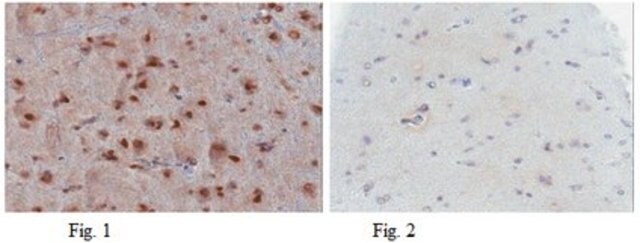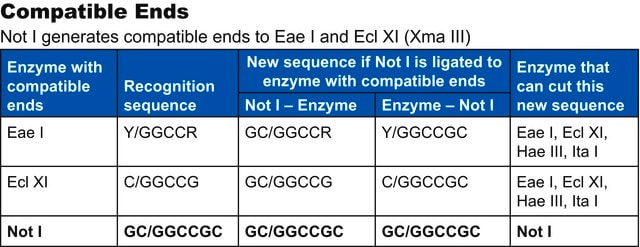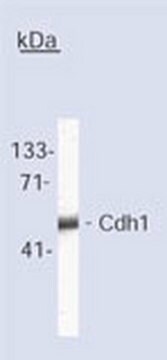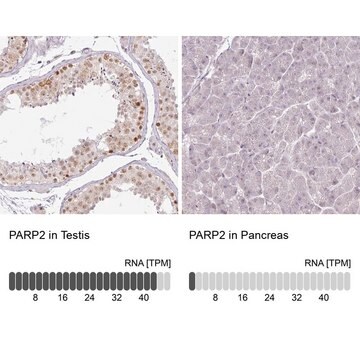Wszystkie zdjęcia(1)
Key Documents
R8381
Dpn I from Diplococcus pneumoniae
Restriction Enzyme
Zaloguj sięWyświetlanie cen organizacyjnych i kontraktowych
About This Item
Numer CAS:
Numer MDL:
Kod UNSPSC:
12352204
Polecane produkty
klasa czystości
for molecular biology
Postać
buffered aqueous glycerol solution
stężenie
10,000 units/mL
Warunki transportu
wet ice
temp. przechowywania
−20°C
Specyficzność
Recognition sequence: 5′-GmA/TC-3′
Ligation and recutting results: After 2-10-fold Dpn I overdigestion of 1 μg pBR322 DNA substrate, results in 100% cutting, >30% of fragments can be ligated, and >90% recut.
Heat inactivation: 75 °C for 15 minutes.
Ligation and recutting results: After 2-10-fold Dpn I overdigestion of 1 μg pBR322 DNA substrate, results in 100% cutting, >30% of fragments can be ligated, and >90% recut.
Heat inactivation: 75 °C for 15 minutes.
Zastosowanie
DpnI is a restriction endonuclease that is used in molecular biological applications to cleave the recognition sequence 5′-GmA/TC-3′, generating DNA framents with blunt ends.
Inne uwagi
Supplied with 10x Restriction Enzyme Buffer SA (B7531).
Comment: Since Dpn I will completely cleave only fully methylated pBR322 DNA, cleavage of 95% or more is considered complete digestion.
Postać fizyczna
Solution in 10 mM Tris-HCl, pH 8.0, 400 mM NaCl, 0.1 mM EDTA, 1 mM dithiothreitol, 200 μg/ml BSA, 50% glycerol (v/v) at 4 °C
This page may contain text that has been machine translated.
bufor inkubacyjny
Numer produktu
Opis
Cennik
produkt powiązany
Kod klasy składowania
10 - Combustible liquids
Klasa zagrożenia wodnego (WGK)
WGK 1
Temperatura zapłonu (°F)
Not applicable
Temperatura zapłonu (°C)
Not applicable
Certyfikaty analizy (CoA)
Poszukaj Certyfikaty analizy (CoA), wpisując numer partii/serii produktów. Numery serii i partii można znaleźć na etykiecie produktu po słowach „seria” lub „partia”.
Masz już ten produkt?
Dokumenty związane z niedawno zakupionymi produktami zostały zamieszczone w Bibliotece dokumentów.
S Lacks et al.
The Journal of biological chemistry, 250(11), 4060-4066 (1975-06-10)
A deoxyribonuclease specific for methylated DNA was isolated from Diplococcus pneumoniae. The enzyme, an endonuclease, degrades DNA for Escherichia coli to fragments of average molecular weight about half a million; it forms discrete fragments from phage lambda DNA. Methyl-deficient E.
Min Ju et al.
The Journal of biological chemistry, 278(15), 12769-12778 (2003-02-01)
The human and rat forms of the Kv2.1 channel have identical amino acids over the membrane-spanning regions and differ only in the N- and C-terminal intracellular regions. Rat Kv2.1 activates much faster than human Kv2.1. Here we have studied the
K Alheim et al.
Journal of molecular endocrinology, 30(3), 359-368 (2003-06-07)
Glucocorticoids are known regulators of the cell cycle, normally exerting an anti-proliferative effect. We have previously shown that glucocorticoids stimulate expression of p57(Kip2), a member of the Cip/Kip family of cyclin-dependent kinase inhibitors which, in some cell types, may account
C Kessler et al.
Gene, 92(1-2), 1-248 (1990-08-16)
The properties and sources of all known class-I, class-II and class-III restriction endonucleases (ENases) and DNA modification methyltransferases (MTases) are listed and newly subclassified according to their sequence specificity. In addition, the enzymes are distinguished in a novel manner according
Cong Zhu et al.
Nucleic acids research, 41(4), 2455-2465 (2013-01-11)
Zinc-finger nucleases (ZFNs) have been used for genome engineering in a wide variety of organisms; however, it remains challenging to design effective ZFNs for many genomic sequences using publicly available zinc-finger modules. This limitation is in part because of potential
Nasz zespół naukowców ma doświadczenie we wszystkich obszarach badań, w tym w naukach przyrodniczych, materiałoznawstwie, syntezie chemicznej, chromatografii, analityce i wielu innych dziedzinach.
Skontaktuj się z zespołem ds. pomocy technicznej








